File this one under the category: Stuff Parents Notice But Don’t Discuss
You have a child. The child is quite young, let’s say two years of age. The child loves books about tools, ladders, and banjos (and you would be shocked just how many books for kids contain at east one of those three items). What the child loves most in this great big, wide, wonderful world, though, is construction equipment. Excavators and backhoes (don’t call them diggers). Cement mixers and forklifts. And so you, good dutiful parent that you are, go off and attempt to find as many construction equipment books as possible so as to feed this insatiable need.
Time passes. The child is very fond of the books you have chosen. So fond, in fact, that they’ve taken to having you read them over and over and over again in succession. And the adult brain, while capable of doing this, begins to realize that the information coming in is the exact same information that came in five and ten and fifteen minutes ago. So the brain begins to search for meanings in the books. Connections. Something, anything really, to keep it occupied. And that’s when you notice it. Right there. Clear as crystal.
The genders of various pieces of construction equipment.
Because, you see, you cannot check out endless books on crane trucks and steam rollers before you notice how these books choose to gender their anthropomorphized mechanicals.
Today, ladies and gentlemen, we pick apart precisely why one book or another chooses to make a wrecking ball a boy or a grader a girl. Bear with me here. I’ve read a LOT of these books. I need to do something with this information or I may burst.
But first, some history!
History Time
Go to your shelves and pick yourselves up a copy of Richard Scarry’s Best Word Book Ever. A staple of the toddler set, and a fixture on living room bookshelves since the year of its publication, 1963.
Now if you’ll take out your copy of Wild Things: Acts of Mischief in Children’s Literature and turn to page 69 you will find a remarkably well-written passage (*puffs self up*) regarding Mr. Scarry and gender in his books. It reads, “By the 1970s, author/illustrator Richard Scarry was the object of much feminist criticism for his repeated portrayal of female characters in passive domestic roles in his many picture books showing community workers. But Scarry eventually heeded the cries of sexism aimed at him.” He updated the characters in his book. Back in 2013 I wrote a piece called “Are there any girl bears?”: Gender and the 21st Century Picture Book featuring this fun bit of side-by-side comparison between the original Word Book and its revised edition:
Of course, once you know about the update, the changes are shockingly obvious. Scarry didn’t really bother to match the linework when he redid his art. Or maybe it’s just that the printing technology of the day made for a stark difference in the original and updated characters. Here are two good examples of what I mean:
As you can see, the original images are using these deeper watercolor shades while the new images are much lighter and simpler. I do, however, have to give the man credit for the taxi driver in pearls.
And you know what? I don’t care if the female characters do look Photoshopped in. I’m grateful, dammit, that there are some women doing labor above and beyond secretarial work. Scarry even occasionally put men in roles traditionally considered to be the women’s territory. Mr. Bunny makes breakfast for the family, for example.
Which brings us, naturally, to the present day. In the 1970s there was a big push for diverse books and titles with gender equal characters. Time passed and this pressing need became just a bit less pressing. So let’s take a group of construction equipment titles as an example and see how the ladies fare. After all, if Scarry updated this bear to look like this:
then how hard can it be for books today?
I’ll separate these books into two categories. The first are anthropomorphized vehicles. The second, construction workers. This is by no means a complete listing. It’s just what I’ve observed in my own life.
Gendered Construction Equipment
Digger, Dozer, Dumper by Hope Vestergaard, ill. David Slonim
MAN, I love this book. I recently got a copy for my son to see, having remembered it a little late. The edition I received from the library was sparkling and pristine. You know why? Because it’s shelved in the poetry section of the library and few folks think to look there for their construction books. Now I love the way Vestergaard never cheats on a rhyme, that’s true. But really and truly what I adore about the book is the variety of genders she grants her unusually animate objects. The skid-steer loader, excavator, ambulance, steamroller, and forklift all identify as female.
Slonim does give big long eyelashes to all the female vehicles, which seems a bit excessive. You don’t need eyelashes on a Skid-Steer Loader, after all. But as it happens, eyelashes are the preferred method of gender identification on trucks. You can see this as well in:
Go! Go! Go! Stop! by Charise Mericle Harper
In this book there’s only one female piece of equipment and it’s the dump truck.
Not quite as extensive as Vestergaard’s book, but it’s still good to have her there. Again, Harper goes in for eyelashes. Scarry used bows. It’s all relative.
Mighty Dads by Joan Holub, ill. James Dean
An interesting case. Dean doesn’t go in for eyelashes and Holub seemingly gives some of the little construction vehicles female names (“Mitzy” is one of them). It’s not 100% clear, but you can read into it what you like. I think it counts.
Goodnight Goodnight Construction Site by Sherry Duskey Rinker, ill. Tom Lichtenheld
Ah. Alas. My son adores this book. He recently got a stuffed version of the excavator for his birthday and he simply could not be more pleased. But while the pieces of equipment do have genders, they’re all male.
Bulldozer’s Big Day by Candace Fleming, ill. Eric Rohmann
All boy, all the time too.
Gender of Construction Workers
I’ll be the first to tell you that of all the construction workers who have been helping to build the duplex next door to my house, not one of them has been female. Still and all, there is a benefit to young readers seeing girls build in some way. So with that in mind . . .
Dig, Dogs, Dig: A Construction Tail by James Horvath (and subsequent sequels like Build, Dogs, Build and Work, Dogs, Work)
I’m writing this at a bit of a disadvantage. I’ve seeing Dig and Build but I haven’t seen Work quite yet. Still, on the basis of the first two books in the series, I have one comment: Roxie needs to do some real work. You see, in the book there’s this pink dog named Roxie who joins the apparently all-male crew on their digs (yes, she has eyelashes). The problem is that Roxie doesn’t have much to do. For example, on the back of Build, Dogs, Build you can see her welding:
But inside they changed it so that the dog doing the welding wasn’t her. All Roxie got to really do in this book was install a doorbell. Dig, Dogs, Dig wasn’t much better. There she just handed down hammers. I’ll be looking at Work, Dogs, Work soon. Hopefully they put that gal through her paces. She needs to earn her keep!
Construction by Sally Sutton
Very nicely done. It’s not overt but the construction workers do include female crew members.
Whose Trucks? by Toni Buzzeo, ill. Jim Datz
These board books are fantastic. Men and women work together everywhere. Also, the kids playing with the trucks at the end of the book are a boy and a girl. If you haven’t seen this, as well as its companion piece Whose Tools? then you are missing out, my friend.
Diggers Go by Steve Light
My son doesn’t have many words but one word he does have is “man”. “Man? Man?” he asks as he points to the construction equipment in this book. He’s not wrong. You might argue that since the faces are in silhouette there’s no way to really tell if the drivers are men or women, and you’d be right. Still and all they look like dudes. When Light puts women in these positions, they tend to have ponytails. The sole ding in what is otherwise a magnificent series.




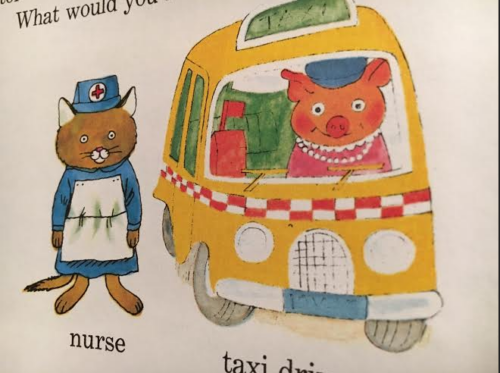
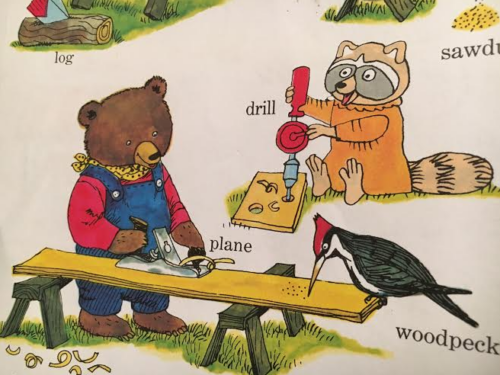
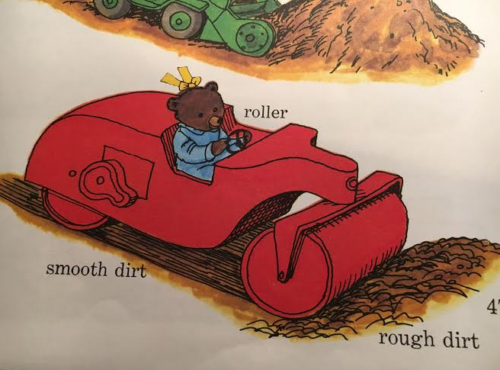
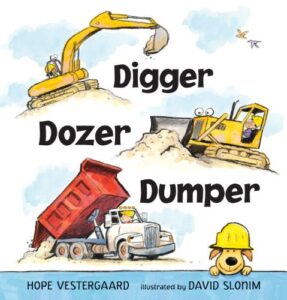




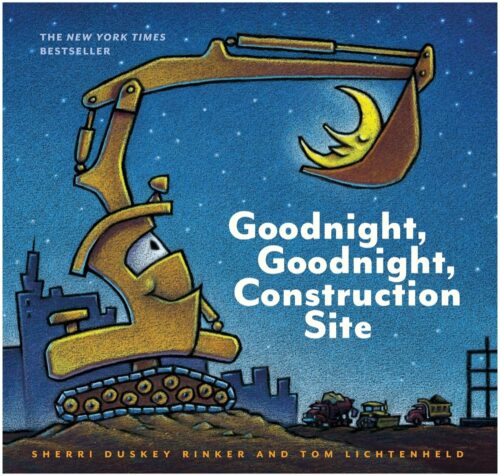
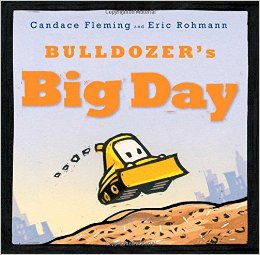

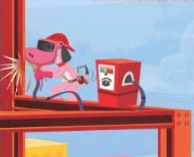


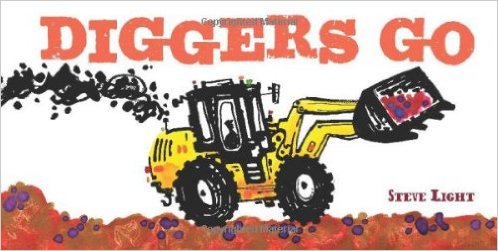
Great post!
Am I right in remembering that the tiny people in “Who Made This Cake?” are nongendered?
It’s interesting that eyelashes are used to show the female, because females don’t, in fact, have longer eyelashes than males. I wonder if Disney is the original source of this idea. You can see the illustrator’s difficulty–modern women and girls don’t really wear bows in their hair any longer, any more than they wear aprons or stick-out skirts, so it’s hard to find a clothing item that signals “female” to a modern child (a bra? high heels? The pearls on the taxi driver weren’t such a bad choice…) Since there are few items of clothing that signal “female” to the modern child, it’s up to the author, not the illustrator, to use personal pronouns, but that leads us into a binary concept of gender–are there no transgendered canine construction workers? And what about religious diversity? We need canine construction workers with head scarves, yarmulkes, and rosaries trailing out of their pockets!
Yet another excellent excuse to reread WHO MADE THIS CAKE.
To answer one of the points here: Boobs. I’ve found there’s an increase in female animals with mammaries. I’ve not done a post on it yet, but curvy ladies are another method of gender identification. For animals anyway. I’ve yet to see a Gibson Girl-esque steam shovel.
Byron Barton’s Machines at Work has several hard-working female construction workers. Boobs give them away, for sure, though a few also sport ponytails.
We’re mostly past the truck infatuation, though GGCS was read an hour or so ago. It’s one of my favorite books to just flip the genders. When I read it, they’re all girls. And we have loads of Richard Scarry on our shelves, mostly vintage. I’m going to have to go see what illustrations we have and how well they’re redone (if they are in our editions)
And we have loads of Richard Scarry on our shelves, mostly vintage. I’m going to have to go see what illustrations we have and how well they’re redone (if they are in our editions)
How about Mike Mulligan and his gal Mary Anne? The genesis of man and his digging machine in kidlit. I seem to recall in the the musical (super charming, viewed on VHS) version all the electric and diesel ones were all eyelashes and sassy swagger.
Nice topic to reflect on.
Demolition by Sally Sutton is also a big hit at my house. And there’s a third one from Sutton and Brian Lovelock as well–Roadwork.
My femininity-in-picture-books obsession of the moment is women and girls in dresses. Why so many dresses? I demand more pants!
Living in a boom state amid a great deal of construction activity, I can’t say I’ve seen any women in the ranks of the workers. Never once in road construction. Is there a particular reason children’s books need to pretend otherwise, or credit the wrong gender with doing this work? Color me confused by this twee discussion.
Ah! Just yesterday I got an email from an author who said (and I quote), ” I have a good friend who recently became the first female line-man (she insists that’s what she is) for the electric company here in Philly. She goes out in rainstorms and late at night to climb the poles and figure out what went wrong with electricity. It’s a big deal, and she was someone I was thinking about as I wrote this stuff.”
I’m not saying every single construction book needs ladies in it, of course. But when you do include them you’re basically telling girls that it’s an option. Like that line-worker my friend told me about. So I like to highlight ’em.
Hello, Anonymous–I’m the previous Anonymous. I think you raise a fair question, and one that occurred to me–like you, I seldom see female construction workers.
A couple of thoughts. One: I suppose children’s books are supposed to show possibilities as well as realities. I grew up in the fifties, a time when doctors were men and nurses were women. During my lifetime, that has changed, and children’s books have changed, too. Did the books reflect the change after it happened? Or is it possible that there were children who saw women doctors–or black doctors–in the pages of their picture books, and entertained an idea that hadn’t been there before? Who can say?
Another thought: I think the reason why children are so often fascinated by construction equipment is because the bulldozers and cement mixers are so powerful. They inspire awe. Children are small, and the idea of controlling big machines, of building big structures, is heady. If I’m right, and fantasies about trucks and cement mixers are fantasies about power, it seems only fair to show all kinds of people–(or dogs)–exercising that power.
Which, in a sense, is why the Dino-Trucks series was as smart as it was. Well put.